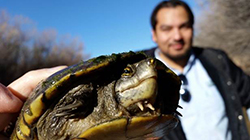Quitobaquito and Rio Sonyota Conservation Projects

Staff surveying for Sonoyta mud turtles
Photo: ASDM/Amy Orchard

Sonoyta mud turtle - Rio Sonoyta
Photo: ASDM/Amy Orchard

Desert pupfish
The Arizona-Sonora Desert Museum was recently awarded grant funds to collaborate with Organ Pipe Cactus National Monument and the Pinacate Biosphere Reserve in Sonora, Mexico. The purpose of the project is to support the implementation of both in situ and ex situ conservation actions related to the Quitobaquito pupfish and Sonoyta mud turtle, provide for public education, and forge partnerships between sister parks and non-governmental institutions. Actions include research and monitoring of these species, surveys of invasive species, establishment and enhancement of off-site facilities for maintaining assurance populations, public education and outreach. Target habitats include Quitobaquito Springs in Organ Pipe Cactus National Monument, Arizona and the Rio Sonoyta in the Pinacate Biosphere Reserve, Mexico.
Water resources in the Sonoran Desert are vital to both wildlife and people. It is tied to almost every resource we rely on. 85% of wildlife species depend on surface water or an associated riparian habitat in some phase of their life cycle. The urgency is to act to conserve wildlife species now as habitat conversion and the introduction of game fish and other exotic species, take the place of native fish populations on both sides of the border.
The Arizona-Sonora Desert Museum currently maintains a population of desert pupfish and Sonora mud turtles that were removed from Quitobaquito due to drastic declines of the water table. Currently the Museum maintains 30 turtles, since 2008 and approximately 1000 pupfish since the mid-1980’s. The animals assure a source for emergency reintroduction and serve as a viable back-up population. ASDM will continue the care and support of both species.
People and communities on both sides of the border are recognizing the value of healthy riparian ecosystems and are working together to preserve and restore them. As the desert web of life loses more strands, the fabric of the ecosystem becomes more impoverished and, thus, less resilient to climate change and other stresses.
We encourage you to visit the Desert Museum’s riparian exhibit to learn more about these species and view pupfish up close and personal! Stay tuned through our conservation blog included below.
- 3 Parks: 1 Partnership - Part 1
- 3 Parks: 1 Partnership - Part 2
- 3 Parks: 1 Partnership - Part 3
- 3 Parks: 1 Partnership - Part 4
For more information, contact: Marie Long mlong@desertmuseum.org

Ramon Rameriz, Miguel Gregada and Marie Long at Quitovac Oases
Photo: ASDM/Amy Orchard